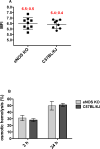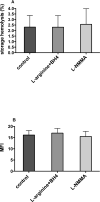Red blood cell endothelial nitric oxide synthase does not modulate red blood cell storage hemolysis
- PMID: 22897637
- PMCID: PMC4313879
- DOI: 10.1111/j.1537-2995.2012.03850.x
Red blood cell endothelial nitric oxide synthase does not modulate red blood cell storage hemolysis
Abstract
Background: The red blood cell (RBC) endothelial nitric oxide synthase (eNOS) has been shown to regulate intrinsic RBC rheologic properties, such as membrane deformability, suggesting that a functional eNOS could be important in RBC viability and function during storage. This study examines the correlation between RBC eNOS deficiency and the propensity of RBCs to hemolyze under selected stress conditions including prolonged hypothermic storage.
Study design and methods: Fresh or stored RBCs from normal and eNOS knockout (KO) mice or from healthy human volunteers were subjected to selected hemolytic stress conditions including mechanical stress hemolysis, osmotic stress hemolysis, and oxidation stress hemolysis and evaluated during standard storage in CPDA-1 solutions.
Results: Fresh RBCs from normal and eNOS KO mice demonstrated comparable susceptibility to hemolysis triggered by mechanical stress (mechanical fragility index 6.5 ± 0.5 in eNOS KO vs. 6.4 ± 0.4 for controls; n = 8-9), osmotic stress, and oxidative stress. Additionally, RBCs from both mouse groups exhibited similar hemolytic profile at the end of 14-day hypothermic storage, analogous to 42 days of human RBC storage. Storage of human RBCs (28 days in CPDA-1) in the presence of NOS cofactors (L-arginine and tetrahydro-L-biopterin) or inhibitor (N(5) -[imino(methylamino)methyl]-L-ornithine monoacetate) did not affect cell recovery or hemolytic response to the selected stressors.
Conclusion: These studies suggest that RBC eNOS does not modulate susceptibility to hemolysis in response to selected stress conditions or prolonged hypothermic storage. Other strategies to increase nitric oxide (NO) bioactivity after prolonged storage utilizing NOS-independent pathways such as the nitrate-nitrite-NO pathway may prove a more promising approach.
© 2012 American Association of Blood Banks.
Conflict of interest statement
Conflict of interest: The authors declare no conflict of interest relevant to this paper
Figures









Similar articles
-
Endothelial nitric oxide synthase in red blood cells: key to a new erythrocrine function?Redox Biol. 2014 Jan 9;2:251-8. doi: 10.1016/j.redox.2013.12.027. eCollection 2014. Redox Biol. 2014. PMID: 24494200 Free PMC article. Review.
-
Red blood cells from endothelial nitric oxide synthase-deficient mice induce vascular dysfunction involving oxidative stress and endothelial arginase I.Redox Biol. 2023 Apr;60:102612. doi: 10.1016/j.redox.2023.102612. Epub 2023 Jan 13. Redox Biol. 2023. PMID: 36681048 Free PMC article.
-
Red Blood Cell and Endothelial eNOS Independently Regulate Circulating Nitric Oxide Metabolites and Blood Pressure.Circulation. 2021 Sep 14;144(11):870-889. doi: 10.1161/CIRCULATIONAHA.120.049606. Epub 2021 Jul 7. Circulation. 2021. PMID: 34229449 Free PMC article.
-
Blood donor obesity is associated with changes in red blood cell metabolism and susceptibility to hemolysis in cold storage and in response to osmotic and oxidative stress.Transfusion. 2021 Feb;61(2):435-448. doi: 10.1111/trf.16168. Epub 2020 Nov 4. Transfusion. 2021. PMID: 33146433 Free PMC article.
-
RBC NOS: regulatory mechanisms and therapeutic aspects.Trends Mol Med. 2008 Jul;14(7):314-22. doi: 10.1016/j.molmed.2008.05.002. Epub 2008 Jun 6. Trends Mol Med. 2008. PMID: 18539530 Review.
Cited by
-
Functional effects of an African glucose-6-phosphate dehydrogenase (G6PD) polymorphism (Val68Met) on red blood cell hemolytic propensity and post-transfusion recovery.Transfusion. 2024 Apr;64(4):615-626. doi: 10.1111/trf.17756. Epub 2024 Feb 23. Transfusion. 2024. PMID: 38400625 Free PMC article.
-
ZOOMICS: Comparative Metabolomics of Red Blood Cells From Guinea Pigs, Humans, and Non-human Primates During Refrigerated Storage for Up to 42 Days.Front Physiol. 2022 Mar 21;13:845347. doi: 10.3389/fphys.2022.845347. eCollection 2022. Front Physiol. 2022. PMID: 35388289 Free PMC article.
-
Oxidative Stress and Arginine/Nitric Oxide Pathway in Red Blood Cells Derived from Patients with Prediabetes.Biomedicines. 2022 Jun 14;10(6):1407. doi: 10.3390/biomedicines10061407. Biomedicines. 2022. PMID: 35740426 Free PMC article.
-
Endothelial nitric oxide synthase in red blood cells: key to a new erythrocrine function?Redox Biol. 2014 Jan 9;2:251-8. doi: 10.1016/j.redox.2013.12.027. eCollection 2014. Redox Biol. 2014. PMID: 24494200 Free PMC article. Review.
-
Intradonor reproducibility and changes in hemolytic variables during red blood cell storage: results of recall phase of the REDS-III RBC-Omics study.Transfusion. 2019 Jan;59(1):79-88. doi: 10.1111/trf.14987. Epub 2018 Nov 8. Transfusion. 2019. PMID: 30408207 Free PMC article.
References
-
- Ozuyaman B, Grau M, Kelm M, Merx MW, Kleinbongard P. RBC NOS: regulatory mechanisms and therapeutic aspects. Trends Mol Med. 2008;14:314–22. - PubMed
-
- Kleinbongard P, Schulz R, Rassaf T, Lauer T, Dejam A, Jax T, Kumara I, Gharini P, Kabanova S, Ozuyaman B, Schnurch HG, Godecke A, Weber AA, Robenek M, Robenek H, Bloch W, Rosen P, Kelm M. Red blood cells express a functional endothelial nitric oxide synthase. Blood. 2006;107:2943–51. - PubMed
-
- Rifkind JM, Nagababu E, Ramasamy S. Nitric oxide redox reactions and red cell biology. Antioxid Redox Signal. 2006;8:1193–203. - PubMed
-
- Bor-Kucukatay M, Wenby RB, Meiselman HJ, Baskurt OK. Effects of nitric oxide on red blood cell deformability. Am J Physiol Heart Circ Physiol. 2003;284:H1577–84. - PubMed
Publication types
MeSH terms
Substances
Grants and funding
LinkOut - more resources
Full Text Sources
Other Literature Sources
Molecular Biology Databases
Research Materials

